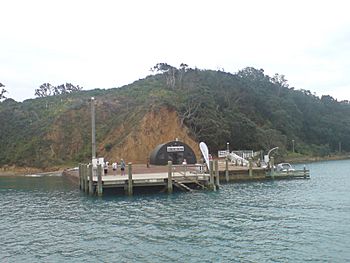Rotoroa Island facts for kids
Rotoroa Island is a beautiful island located east of Waiheke Island in New Zealand's Hauraki Gulf. It covers about 82 hectares (203 acres). For nearly 100 years, the island was a private place. The Salvation Army bought it in 1908 to use as a special care facility. This facility helped people and was closed in 2005.
In 2008, a family named Plowman helped create the Rotoroa Island Trust. They leased the island for 99 years. Their goal was to bring the island back to life and open it for everyone in New Zealand to enjoy. Rotoroa Island finally opened to the public in February 2011, after more than a century.
Contents
Protecting Wildlife on Rotoroa Island
The Rotoroa Island Trust wants the island to be a safe home for New Zealand's amazing wildlife. They hope visitors can experience the wonder of these animals.
Auckland Zoo helped the island's conservation team. They chose which native animals would be good to move to the island. These animals include takahē, pāteke (brown teal ducks), tīeke (saddleback birds), and North Island brown kiwi.
How Rotoroa Island Helps Kiwi Birds
Rotoroa Island is a special "creche" site for Coromandel Brown Kiwi. A creche is like a nursery where young kiwi chicks can grow up safely. In the wild, only about 5% of kiwi chicks survive. But with a program called Operation Nest Egg, survival rates jump to 50-60%.
Tiny kiwi chicks are brought to Rotoroa Island when they are just a few weeks old. They weigh only about 250-300 grams. On the island, they can grow big and strong without danger. Every two years, the island team gathers the adult kiwi birds. These mature kiwi weigh about 1 kilogram. They are strong enough to protect themselves from predators like stoats and wild cats. Some of these kiwi are returned to the Coromandel area. Others go to nearby Motutapu Island to start new kiwi families there.
Takahē: A Story of Survival
Rotoroa Island is one of ten smaller sanctuaries helping to save the takahē. These large, flightless birds were once thought to be extinct over 70 years ago. Since 2015, Rotoroa has been a "creche" for takahē chicks.
The Department of Conservation (DoC) runs the Takahē Recovery Programme. Their goal is to protect these endangered birds and help their population grow. In 2020, there were 418 takahē birds.
Other Endangered Animals on the Island
Rotoroa Island is also a safe haven for other rare New Zealand animals. In 2020, more than 9 little pāteke chicks hatched on the island. These small ducks were once common across New Zealand. Now, they are very rare on the mainland, with only about 2,000-2,500 left.
The population of Tīeke (saddleback birds) has also more than doubled. This growth happened between March 2015 and October 2019.
Restoring the Island's Natural Beauty
The Rotoroa Island Trust has done a lot of work to restore the island.
- They removed 22,000 pine trees that were not native to the island.
- They planted over 400,000 native New Zealand trees. These include more than 25 different types of trees, like 30,000 Pohutukawa Trees.
- The island was declared free of pests in 2014. This was a very successful effort. They removed over 300,000 mice using special bait drops from the air.
- Now, Rotoroa Island uses over 50 traps and 50 tracking tunnels. These help them check for any new pests.
- They have also fixed up three holiday homes and a shared hostel. This allows people to stay overnight on the island.
- A museum designed by architect Rick Pearson was built. It has an exhibition about the island's history.
- A large sculpture by New Zealand artist Chris Booth was placed at the island's southern tip.
Island Plants and Trees
Kauri seedlings were given to the trust. These young kauri trees have been planted in the forest above the Ladies Bay wetlands.
Rotoroa Island aims to be a carbon neutral island. This means the trees planted are expected to remove twice the amount of carbon that the island produces.
Images for kids
See also
 In Spanish: Isla Rotoroa para niños
In Spanish: Isla Rotoroa para niños



